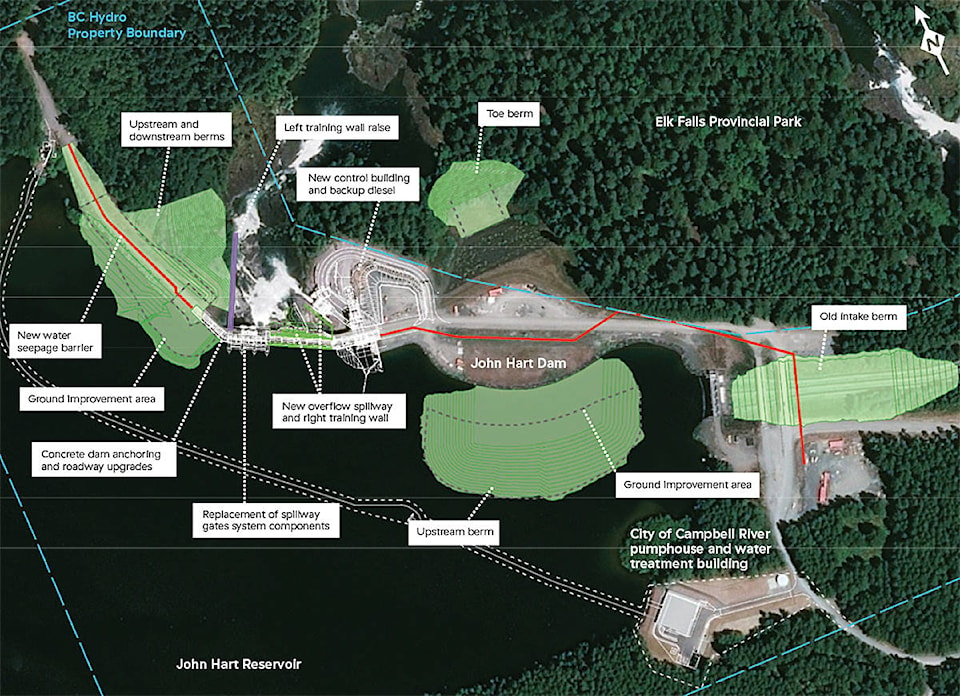BC Hydro’s planned seismic upgrades to the John Hart Dam are targeted to strengthen the dam so that it can withstand a major earthquake.
The design work to achieve that goal continues to be refined.
“The feasibility design stage has been completed and we are now fine tuning the design of the proposed works that include upgrades to the earthfill and concrete sections of the dam, a new overflow spillway under the road deck near the spillway gates, and the replacement of the three spillway gates and related works,” said BC Hydro spokesperson, Stephen Watson. “This includes optimization of size of the upstream and downstream berms that will widen the dam to make it seismically stronger, and the length and placement of a new water seepage cutoff wall that provides an impermeable barrier to contain the reservoir even after a major earthquake. From this process we will get a final design.”
In fall 2018, through extensive investigative work, BC Hydro announced it was no longer planning to have a 10-metre John Hart Reservoir level drawdown to complete the upgrade work. That was a significant benefit to the City of Campbell River on reservoir water quality considerations and their domestic water extraction from the reservoir, which is close to the dam.
“We are looking at the constructability of the upstream berm and first we’ll need to dredge the reservoir bottom, likely using a crane with clam-shell bucket, to remove poorly compacted material,” said Watson. “Once that’s done we’ll place new rockfill in that area to construct the upstream berm. Throughout that whole process we are looking to use silt curtains to isolate the work area from the rest of the reservoir so there’s no turbidity issues for fish or domestic water supply. We want to prevent any adverse environmental impact.”
Watson says the removed material from the reservoir bottom is planned to be placed along the old woodstave penstock corridor, which would better level off the currently ditched area and better fit in with the surrounding land. The corridor area would then eventually be returned to forest.
Another project component that was fine-tuned was the design of the overflow spillway. To support numerical modelling, a physical hydraulic model was developed in a lab in North Vancouver to test the performance of the proposed overflow spillway, when operating together with the existing spillway or independently.
Improvements to the spillway gates section of the concrete dam are also being further developed, and include new gates, hoist towers, controls and backup power systems.
BC Hydro is developing an environmental and socio-economic impacts assessment for the project to support the overall BC Utilities Commission project application that is currently targeted for submission in 2021. The procurement process is also targeted to begin in 2021 and construction may begin in late 2023. Once construction begins the Brewster Lake Road that crosses over the dam may be closed for about four to five years.
BC Hydro continues to meet and consult with First Nations, government agencies and stakeholders on the project. Information on the project, as well as the proposed Strathcona Dam Water Discharge Upgrade Project and Ladore Spillway Seismic Upgrade Project, is available at BC Hydro’s Campbell River Hydroelectric Facilities Discovery Centre at the Elk Falls parking lots, which is open Tuesday, Thursday and Saturday. Project community engagement comment forms are available to be filled out.
“The potential of a John Hart Dam failure from a severe earthquake is a risk until it’s seismically upgraded,” said Watson. “Since 2014, we’ve worked closely with the City of Campbell River and the Strathcona Regional District on the interim downstream risk and the public key message, ‘If it knocks you down, go to high ground.’ When our upgrade project is complete in around 2028, the dam will be able to safely withstand extreme levels of ground shaking.”
“We appreciate BC Hydro’s ongoing efforts to make their facilities safe and reliable for seismic events,” said City of Campbell River Mayor, Andy Adams. “The John Hart Generating Station Replacement Project was a big success and now the next step is a seismically safe dam. City staff and City Council continue to be fully engaged in the project, whether about reservoir water quality during construction or overall dam safety, including the interim downstream risks until the upgrades are complete. We are also engaged and very supportive of their Ladore and Strathcona facility upgrade projects.”
The John Hart Dam holds back water within the John Hart Reservoir. Constructed in the 1940s the dam is 34 metres high and just over 800 metres long, and is made of compacted earthfill with a concrete spillway dam. There have been various upgrades to components of the dam over the years.
For any enquiries about the project please contact Stephen Watson at 1-250-755-4795 or steve.watson@bchydro.com.
RELATED: Design work underway on Strathcona Dam upgrade near Campbell River
